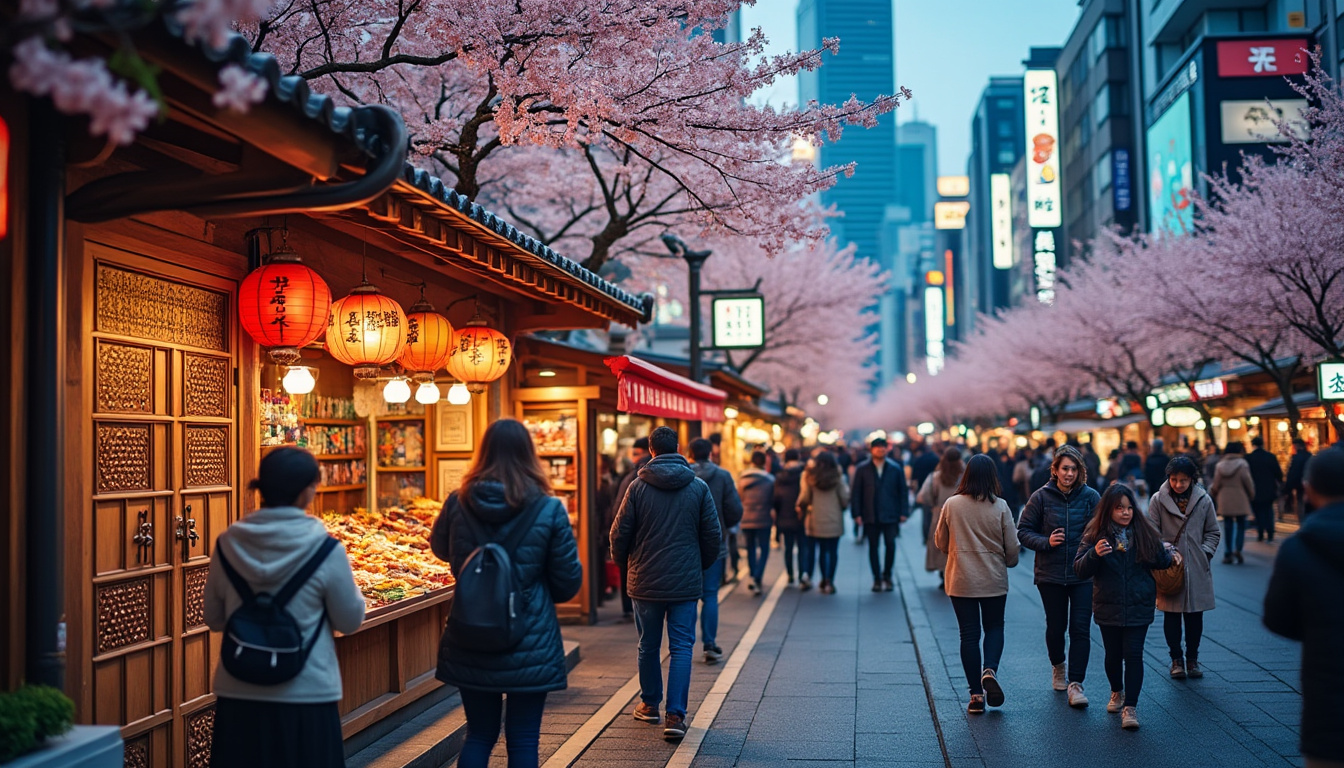Tokyo stands as a vibrant gateway to the dynamic allure of Japan, offering travelers an extraordinary blend of ancient traditions and futuristic innovation. Visitors flying into Narita, especially with new daily service from Seattle via Hawaiian Airlines, are poised to unlock a wealth of authentic experiences. Navigating this bustling metropolis requires insights beyond guidebooks, tapping into the firsthand expertise of seasoned airline crew members who intimately know Japan’s multifaceted charms.
Essential Travel Preparation: Master Seasonal Shifts and Packing for Tokyo
Tokyo’s climate features marked seasonal contrasts, necessitating strategic packing for a comfortable visit. From the cold winters to humid, rain-prone early summers and the vivid palette of cherry blossom spring and autumn leaves, layering is key. Local convenience stores offer handy seasonal accessories, making it easy to adjust on the go.
- Layer clothes to adapt quickly to temperature fluctuations.
- Bring comfortable footwear as Tokyo invites extensive walking.
- Obtain a Suica card, or link it to your iPhone digital wallet for efficient transport access.
- Consider buying a local eSIM for seamless mobile connectivity, essential for navigation and translation apps.
- Pack a reusable tote bag for shopping to avoid extra fees and support eco-friendly travel.
| Season | Typical Weather | Packing Recommendations |
|---|---|---|
| Winter (Dec–Feb) | Cold and dry | Warm coats, hats, gloves, thermal layers |
| Spring (Mar–May) | Cool with cherry blossoms | Light jackets, scarves, comfortable walking shoes |
| Early Summer (Jun) | Monsoon rains and humidity | Waterproof gear, breathable fabrics |
| Summer (Jul–Aug) | Hot and humid | Light clothing, sun protection, cooling accessories |
| Autumn (Sep–Nov) | Cool and colorful foliage | Layered clothing, comfortable shoes |
Seamless Transit and Cultural Norms in Tokyo: Tips from Airline Insiders
Tokyo’s extensive public transit system is world-renowned for its punctuality and reach. However, understanding local etiquette ensures a respectful and smooth commute through crowded trains and buses.
- Load sufficient funds onto your Suica card before starting journeys to avoid delays at gates.
- Keep noise levels low inside trains and buses as a sign of respect.
- Carry backpacks in front to avoid bumping fellow passengers during crowded times.
- Avoid eating while walking; instead, use designated areas to enjoy food.
- No tipping culture: service is impeccable and best acknowledged with a polite bow and “Arigato Gozaimasu.”
| Typical Public Transport Etiquette | Explanation |
|---|---|
| Quietness | Speaking softly to maintain peaceful environment |
| Backpack Handling | Worn in front to avoid accidental hits |
| No Eating While Moving | Respect for fellow commuters |
| Politeness | Bowing instead of tipping as gratitude |
Expert advice for transit cards and connectivity:
- Suica card availability extends beyond stations; digital payment seamlessness encourages visitors to embrace modern tech.
- Local eSIMs ensure continuous online access essential for apps guiding travelers through transit and attractions.
Beyond Tokyo: Exploring Japan’s Diverse Regions by Shinkansen
While Tokyo merits three full days for immersive discovery, Japan’s network of high-speed Shinkansen trains unlocks an unparalleled opportunity to experience the country’s rich regional distinctiveness. Whether it’s the snow-capped landscapes of Nagano, the historic temples of Kyoto, the bustling culture of Osaka, or the poignant sites of Hiroshima, each destination offers unique culinary, historical, and cultural experiences.
- Plan side trips to areas like Nagano for mountainous views or Okinawa for tranquil beaches.
- Visit Kansai for traditional culture and vibrant city life combined.
- Schedule time for onsen visits to unwind in natural hot springs with scenic surroundings.
- Engage with local food scenes, such as culturally authentic Peking Duck inspired by Japan’s diverse palate.
- Use Japan Airlines or Air Japan for connections complementing rail travel.
| Region | Key Attractions | Unique Experience |
|---|---|---|
| Nagano | Snow monkeys, Japanese Alps | Scenic onsen baths and rural landscapes |
| Kansai (Kyoto, Osaka, Nara) | Temples, traditional tea ceremonies, vibrant city life | Historic culture blended with culinary discoveries |
| Hiroshima | Peace Memorial Park, Miyajima Island | Reflective history and nature |
| Okinawa | Beaches, coral reefs | Relaxation and traditional Ryukyu culture |
Authentic Cultural Engagements and Culinary Delights in Japan
Immersing oneself in Japan’s culture extends far beyond sightseeing. Participating in traditional classes such as wagashi confection making, sushi preparation, or the refined sado tea ceremony offers intimate insights. These activities foster genuine connection with local people and deepen appreciation for Japanese artistry.
- Book cultural workshops through tour operators like Inside Japan Tours or Trafalgar for convenient access.
- Experience Tokyo’s innovative dining scene, from bustling street markets to fine restaurants, often listed on platforms like Expedia.
- Don’t miss opportunities to savor regionally distinct specialties, including the famed culturally authentic Peking Duck recipes adapted by Japanese chefs.
- Bring an empty suitcase to accommodate “omiyage,” the unique tradition of purchasing gifts for friends and family.
| Activity | Description | Recommended Providers |
|---|---|---|
| Wagashi making | Learn to craft traditional Japanese sweets | Inside Japan Tours, JTB Corporation |
| Tea ceremony (Sado) | Experience ritualized Japanese tea preparation and appreciation | Trafalgar, UniWorld Boutique River Cruise Collection |
| Sushi classes | Hands-on learning of sushi techniques | H.I.S. Travel, Japanican |
Shopping and Convenience: Navigating Tokyo’s Urban Landscape
Visitors are encouraged to experience Tokyo’s famed convenience stores—or “konbini”—which outclass their Western counterparts in both food quality and product variety. The city’s shopping culture includes a mixture of towering department stores and myriad small vendors, ideal for diverse budgets and tastes.
- Carry cash for street or festival vendors where cards might not be accepted.
- Reserve an extra suitcase for souvenirs, embracing the omiyage tradition.
- Shop smart by supporting local artisans and choosing authentic goods.
- Respect trash protocols by carrying waste until disposal and sorting correctly due to Japan’s strict recycling culture.
- Explore beyond Tokyo for unique specialty products from different prefectures.
| Shopping Location | Offering | Payment Methods |
|---|---|---|
| Konbini (Convenience stores) | Fresh food, essentials, seasonal items | Cash, credit cards |
| Local markets & street vendors | Unique souvenirs, street food | Mostly cash |
| Department stores | Luxury goods, fashion, gifts | Credit cards, digital payments |
FAQ: Insider Tips for Traveling in Tokyo and Beyond
- Q: What is the benefit of purchasing a Suica card for travel in Tokyo?
A: The Suica card allows seamless access to trains, buses, and even some stores, streamlining transportation with cashless convenience. - Q: Are there any cultural sensitivities travelers should be aware of in onsen visits?
A: Yes, many onsen enforce strict tattoo policies and bathing etiquette. Researching in advance helps ensure a respectful experience. - Q: How can travelers best experience authentic Japanese culture?
A: Engaging in workshops like wagashi-making or tea ceremonies offers immersive cultural connections beyond tourist landmarks. - Q: Is tipping customary in Japan?
A: No, tipping is generally not expected; exceptional service is part of Japanese hospitality norms. - Q: What is the best way to manage waste in Tokyo?
A: Carry trash with you due to scarce public bins and follow local recycling rules strictly.


